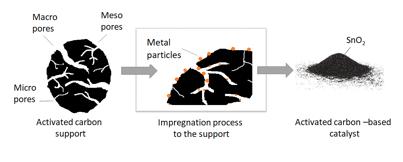
4 minute read
3.3.2 RESULTS
for the porous like structure, which is forming during the polymerization reaction between the individual condensed or hydrolysable tannin molecules. Furfural alcohol is preferred in the polymerization reaction more than formaldehyde due to the toxicity of and environmental impact of it. Practically the bio-based foams were prepared as can be seen in Figure 43.
After the curing of the foams, some characteristics of the foams, such as density, foam rise and mechanical strength were measured. The hardened foams were upgraded to activated carbon foams via chemical or physical activation routes as shown in Figure 44. Later on, the specific surface area. pore volumes and pore size distributions of the foams were analyzed using the nitrogen adsorption technique.
Advertisement
Figure 43. Preparation of the skeletal backbone for carbon-foam support materials using either tannic acid or pine bark extracts. (Varila, T; Mäkelä, E. et al, 2020) Reprinted with permission from Elsevier
Figure 44. Tannin foam upgrading to carbon foams and activated carbon foams with carbonization or physical/chemical activation method (Varila 2020)

Foam synthesis done within this project were conducted using extracts from a mixture of pine and spruce bark or extracts from pine or spruce bark. Extracts were separated from biomass using different solvents followed by, in some cases, purification with ethanol or water. Physical properties such as foam rise and density were calculated from each foam after the foam maturation. The pine or spruce extraction were done in lab scale. According to results, the foam rise and density of the foams were highly dependent on each other as can be seen from Figures 45, 46 and 47.

Figure 45. Relationship between the foam rise and density of the foams made with pine bark extracts. Powder or liquid represents the state of the extracts how they were used in the foaming synthesis
Figure 46. Relationship between the foam rise and density of the foams made with spruce bark extracts. Powder or liquid represents the state of the extracts how they were used in the foaming synthesis
Figure 47. Relationship between the foam rise and density of the foams made with 50/50 spruce and pine bark extracts. Powder or liquid represents the state of the extracts how they were used in the foaming synthesis


In other words, solvent selection plays a major role when extractions of bark are carried out. In case of pine bark, Figure 45, extraction done with ethanol created the best performing foam while the extract extracted with cold or hot water did not give any rise to the foams. Reason for this might be, that with cold water it is not possible to extract enough tannins in order to foam to work properly. On the other hand, hot water extraction will most likely evaporate some of the light-weight polyphenols and dissolve more carbohydrates from the bark.
Spruce bark extracts, Figure 46, worked much better than pine bark extracts in foaming due to the higher tannin content in spruce. Extracts extracted with solvent combination of urea, water and sodium carbonate, yielded the highest foam rise and lowest density for the spruce bark extract based foam. Combination of 60 degree water extraction followed by ethanol washing yielded good foam properties as well.
Extracts extracted from 50/50 mixture of pine and spruce bark where also tested in foam synthesis. In this case the extractions were conducted in pilot scale. From the results presented in Figure 47 it can be stated that with cold water washing followed by hot water extraction lowest density and highest foam rise were obtained. The foam itself was very brittle but compared to pine or spruce bark extracted with water completely different kind of foams were obtained. The other foams prepared from extracts extracted with water + ethanol or just with water at 60 to 80 degree were much harder and durable then the foam prepared from extracts extracted with cold water washing followed by hot water extraction. Reason for this might be that, during hot water extraction some of the volatile materials inside the bark structure are evaporating away and there for the extracts don’t have tannins to sustain the overall foam structure.
Activated carbon foams
Some of the produced foams were further upgraded to activated carbon foams with physical or chemical activation methods as shown in Figure 44. According to the results, presented in Table 8, with steam activation it is possible to achieve specific surface areas around 500- 700 m2/g and with ZnCl2 activation over 1100 m2/g. Also the pore sizes distributions of the foam varied greatly depending on which activation method was used. With steam activation method very microporous carbons are produced and with chemical activation with ZnCl2 mainly mesoporous carbon in formed.

Table 8. Surface analyses of foams activated with steam and ZnCl2







